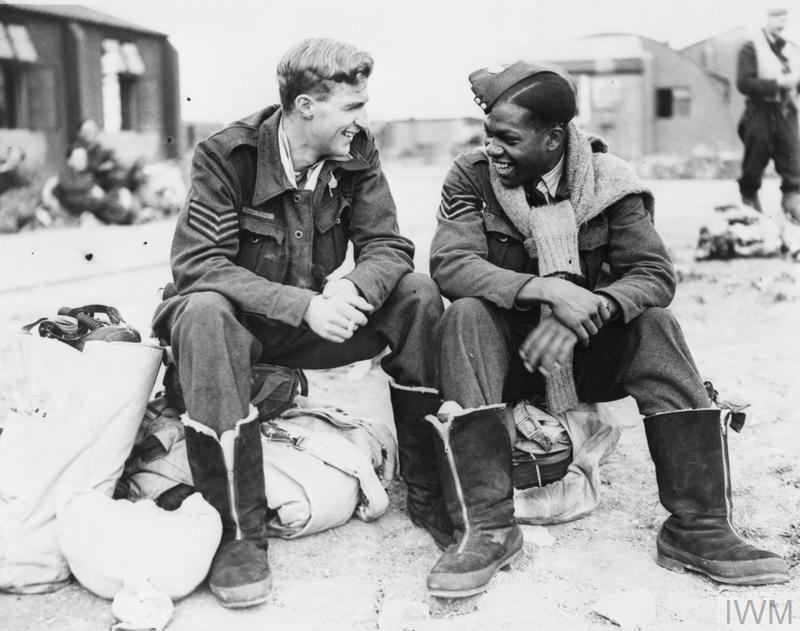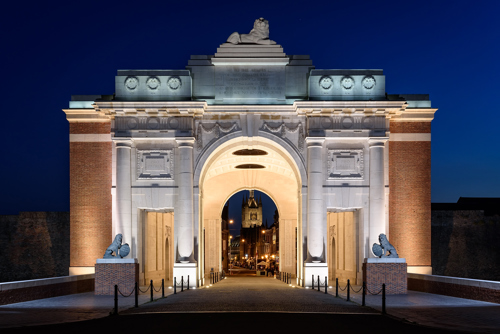10 October 2022
We tell their stories: Black servicemen’s World War experiences
It’s Black History Month. We’re shining the spotlight on the contribution black servicemen made during both. Read on to learn some of their stories.
Black history month

A black Bomber Command crewman shares a joke with one of his teammates (© IWM PL 10348D)
Who were the black service personnel of the World Wars?
By the start of the first World War, the British Empire had established colonies all over the world.
The Caribbean and Africa provided men and women to serve in both World Wars. They covered a huge range of roles and tasks, from logistics troops to frontline soldiers, RAF pilots, nurses and medical personnel, to naval crewmen.
Some volunteered willingly. Others were conscripted or forced into joining. However they came to be part of the war effort, these troops served with the same courage and skill as any of their comrades.
In total, many hundreds of thousands of Caribbean and African people served. For example, in World War One, over 15,000 West Indian troops volunteered to serve, while in the fight for East Africa the British Empire was able to mobilise some 150,000 local troops to fight. They were supported by roughly one million local supply and logistics support soldiers.
There were huge numbers of men and women making important contributions to the war effort.
One of our key goals at the Commonwealth War Graves Foundation is to tell the stories of the Commonwealth’s war dead, let’s look at some of the experiences of black servicemen from World War One and Two.
Lieutenant Euan Lucie-Smith
 Image: Euan Lucie-Smith was one of the first black officers to serve in the British Army during World War One.
Image: Euan Lucie-Smith was one of the first black officers to serve in the British Army during World War One.
The Great War provided opportunities for Caribbean and African men to reach ranks previously unavailable to them.
British Army manuals from the time reveal that officers were only meant to be of “pure European descent”. The coded language essentially restricted black people from reaching commissioned ranks. The manpower needs of World War One put paid to that idea.
Gradually, more and more competent men who didn’t fit the bill would end up commanding men of all races, colours, and creeds.
One of these was Lieutenant Euan Lucie-Smith.
Euan was born in Jamaica to a British father and a Jamaican mother. The Lucie-Smiths were a distinguished family. Euan’s father, John Barkly Lucie-Smith, was Jamaica’s postmaster, for example.
Prior to the outbreak of war in Europe in July 1914, Euan had been commissioned into the Jamaica Artillery Militia. Perhaps it was this experience that helped Euan overcome racial barriers during his time in the British Army.
Euan joined the Royal Warwickshire Regiment as Europe descended into chaos. He arrived in England in 1914 in the war’s early stages. In March 1915, Euan and the men of the Royal Warwickshire 1st Battalion were on their way to France and on into Belgium.
What awaited them were the scenes we now associated with the Western Front: mud, blood, fire, and wire.
In April 1915, Euan, who had reached the rank of Lieutenant, would lead his men into battle for the first time. Tragically, it would prove to be the only time Lieutenant Lucie-Smith would see combat.
Between the 24-25th April, the Warwicks were ordered to advance to the front in West Flanders, specifically Vlamertinghe in the Ypres Salient. Rain began to fall as the city of Ypres, the victim of heavy shellfire, burned.
At 4.30 am on the 25th of April, Euan and the Warwickshires were given the signal to attack.
The nature of Western Front battlefields meant the advantage lay with the defender. Dug-in machine guns, trenches, shell craters, and barbed wire emplacements combined to make attacking a difficult prospect.
 Image: Euan is commemorated on the panels of the Ypres (Menin Gate) Memorial.
Image: Euan is commemorated on the panels of the Ypres (Menin Gate) Memorial.
This was the reality facing Lieutenant Lucie-Smith and his men.
The regiment’s war diary describes the attack: “We attacked the wood on the left of the line with the 7th Argyll and Sutherland Highlanders, the Seaforth Highlanders, Royal Irish Fusiliers, Royal Dublin Fusiliers, attached to our right on St Julien.
“Owning to the German trenches being insufficiently shelled and support unable to come up the line retired at about 7 am to trenches near the farm. Our casualties were very heavy: 17 officers, 500 other ranks, killed, wounded, or missing.”
Euan Lucie-Smith was one of those 17 casualties. The Lieutenant was listed by his regimental war diary as “missing, probably killed”. Eyewitness reports suggest Euan died after receiving a fatal head wound.
His fate will possibly remain a mystery, but Euan holds the uniquely tragic distinction as the first black officer to die in the British Army in World War One.
Because Euan’s body was never recovered, he has no known grave. Euan is commemorated alongside over 50,000 more missing Commonwealth soldiers on the Ypres (Menin Gate) Memorial.
Reverend Isaac Wauchope Dyobha
 Image: Reverand Isaac Wauchope Dyobha proved inspirational during his short wartime service.
Image: Reverand Isaac Wauchope Dyobha proved inspirational during his short wartime service.
As we touched on earlier, many black troops served as labour units in the World Wars.
Their tasks may have been perceived as less glamorous than their frontline troops, but their contribution to the war effort was no less essential.
It was their job to ferry food, water, medical equipment, and ammunition to the frontline. They also built roads and railway links, depending on where they served, and essentially kept up the flow of material an army needs to function.
The South African Native Labour Corps (SANLC) was one such logistics regiment that provided vital transport and logistical services on the Western Front. Around 70,000 of the 300,000 or so labour units drawn from around the British Empire were in the SANL.
One such member of the SANL was Reverend Isaac Wauchope Dyobha.
Isaac was born in 1852 in Doorn Hoek, near Uitenhage on South Africa’s Eastern Cape.
The Dyobhas were an esteemed family of educated men and preachers with a strong conviction in the Christian faith and native rights.
Isaac inherited this family spirit. Before he joined the labour corps, the highly educated preacher was active in multiple spheres of black South African life. He was an active campaigner for land rights for the native Xhosa people, raised funds to establish native educational institutes and was a prominent member of the Church.
His work and campaigning bought him in close contact with South Africa’s white population. Some were allies of Isaac, but many sadly were not.
Isaac joined the South African Native Labour Corps in 1916. According to biographer S.E.K Mqhayi, Isaac volunteered as he had a “high reputation and could obviously help in training the newcomers by explaining white things to them”.
The first contingent of 1,500 SANLC troops reached France on November 20th, 1916. Four more contingents would join them, bringing the total number of South African Native Labour Corps troops on the Western Front up to 8,000 by January 1917.
Isaac was to be part of the next voyage.
 Image: The ill-fated SS Mendi which bore Isaac and his comrades to the UK.
Image: The ill-fated SS Mendi which bore Isaac and his comrades to the UK.
Aboard the SS Mendi, Isaac and more SANLC men set sail on January 25th, 1917. The Mendi stopped en route at Lagos in Nigeria and Freetown in Sierra Leone. After loading up with cargo and supplies, the Mendi made its final stop at Plymouth, UK, on the 19th of February.
Isaac and the Mendi set sail for France on the next day, accompanied by HMS Brisk for the journey across the English Channel.
Setting out in total darkness, a thick fog rolled in as the Mendi steamed across the Channel.
At 4.57 am, around 20km from the Isle of Wight off the UK’s southern coast, the SS Darro suddenly emerged from the fog. The Darro, twice the size of the Mendi, was sailing full speed at Isaac’s troop ship.
There was no time for either ship to adjust its course. The Darro struck the Mendi’s right side, forcing it to lean and take on water. The right-hand lifeboats couldn’t be deployed. What’s worse is the Darro didn’t stop to help its beleaguered sister ship.
Only half the Mendi’s lifeboats were deployed. The situation for the ship’s passengers was getting ever more desperate.
For many of those onboard, it was their first time at sea. Men were beginning to panic as water filled the Mendi and it began to sink beneath the waves.
Amid the chaos, one man acted as a beacon of calm: Reverend Isaac Wauchope Dyobha.
The story goes that Isaac ordered the men to form ranks so he could perform the “Death Dance”. According to the tale, Issac gave the following rousing address:
“Be quiet and calm, my countrymen, for what is taking place is exactly what you came to do. You are going to die, but that is what you came to do. Brothers, we are drilling the death drill. I, a Xhosa, say you are my brothers. Zulus, Swazis, Pondos, Basothos and all others, let us die like warriors. We are the sons of Africa. Raise your war cries my brothers, for though they made us leave our assegais back in the kraals, our voices are left with our bodies.”
HMS Brisk and other ships combed the waters to rescue what men they could. Around 650 men, including Isaac, would never be seen again.
Today, Isaac and the crew of the SS Mendi are commemorated on the Hollybrook Memorial to the Missing in Southampton, UK.
Flight Lieutenant Emanuel Peter John Adeniyi Thomas
 Image: Emanuel Peter John Adeniyi Thomas, the RAF's first West African officer (© IWM CH 7168).
Image: Emanuel Peter John Adeniyi Thomas, the RAF's first West African officer (© IWM CH 7168).
Did you know more than 3,000 West Indian and 6,000 African recruits joined the Royal Air Force during World War Two?
Air and groundcrew numbers were bolstered by servicemen and women from the Caribbean, Nigeria, Sierra Leone, Gambia, and South Africa to name a few.
With the colour bar lifted for the duration of the war, black RAF servicemen were able to take up officer roles in the RAF.
One such man was Nigerian Emanual Peter John Adeniyi Thomas. Peter, or Deniyi as his friends called him, was one of the first West African officers commissioned in the RAF.
The Battle of Britain and the daring courage and skill of “The Few” RAF pilots piqued Peter’s interest when reports of the battle filtered through to Nigeria. Inspired by those gallant airmen, Peter decided to enlist in the RAF and headed to England in September 1942.
Motivations for black servicemen enlisting across the various military branches are mixed. Alongside wanting to emulate the Battle of Britain pilots, Peter had other reasons for joining up.
“My great-grandfather was a chieftain,” Peter wrote. “One day his rival betrayed him to a slave dealer. He was put on a ship along with 100 other slaves and was soon on his way to America. Ten days out in the Atlantic his ship was intercepted by one of Her Majesty’s ships. The slaves were rescued, and at Freetown (Sierra Leone), my great-grandfather regained his freedom.”
Not only was Peter one of the RAF’s first black officers, he was also the first West African to train as a pilot. Thanks to his skill and courage at the controls of his aircraft, Peter quickly earned a commissioned rank.
Over the course of the war, Peter would earn two further promotions. He was promoted to Flying Officer in 1943 and again in 1944 achieving the rank of Flight Lieutenant.
By January 1945, only a short few months before the end of World War Two in Europe, Peter was serving with the RAF’s No.4 Radio School at RAF Madley in Herefordshire in the west of England.
Peter’s role was to train new wireless operators by taking them up in his aircraft. Practising using the radio while in flight was a key part of any RAF flight radio operator’s training.
Peter and trainee radio operator Frank Stokes took off on a training mission on 12th January 1945. The pair flew through poor visibility and inclement weather. This was risky, considering their flight path took them above the peaks of the Brecon Beacons mountains in south Wales.
Struggling to see and battling against poor conditions, Peter’s plane tragically crashed into a mountainside.
Peter was somehow able to pull himself out of the wreckage and stagger some two miles searching for help for himself and his injured passenger.
Unfortunately, Peter died of his injuries.
He is buried in Haycombe Cemetery in Bath. He may not have known it, but Peter died a pioneer, after breaking many barriers previously put up against West Africans in the Royal Air Force.
Help the Commonwealth War Graves Foundation keep telling their stories
We hope you found this blog inspirational and informative.
At the CWGF, we aim to keep the memories of the Commonwealth’s war dead alive so future generations can learn of their incredible sacrifice.
Through our outreach programmes, special events, and education endeavours, we can keep telling their stories – but we need your support.
Consider leaving a donation so we can continue our work in commemorating our war dead.
Why not become a member and enjoy some unique benefits?

